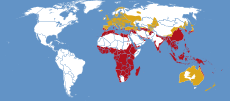Agrius convolvuli
| Agrius convolvuli | |
|---|---|
 | |
| Agrius convolvuli ♂ MHNT | |
 | |
| Agrius convolvuli ♂ △ MHNT | |
| Scientific classification | |
| Kingdom: | Animalia |
| Phylum: | Arthropoda |
| Class: | Insecta |
| Order: | Lepidoptera |
| Family: | Sphingidae |
| Genus: | Agrius |
| Species: | A. convolvuli |
| Binomial name | |
| Agrius convolvuli (Linnaeus, 1758)[1] | |
| Synonyms | |
| |

The Convolvulus Hawk-moth, Agrius convolvuli, is a large hawkmoth. It is common throughout Europe, Africa[2] and Australia.[3] partly as a migrant.
Description and habits
The wingspan is 80–105 mm. This hawkmoth's basic coloration is in grayish tones, but the abdomen has a broad gray dorsal stripe and pink and black bands edged with white on the sides. The hindwings are light grey with darker broad crosslines.
Its favorite time is around sunset and during the twilight, when it is seen in gardens hovering over the flowers. This moth is very attracted to the lights, so it is often smashed by cars in highways. Its caterpillars eat the leaves of the Convolvulus, therefore its Latin name "convolvuli". Other recorded foodplant include a wide range of plants in the Araceae, Convolvulaceae, Leguminosae and Malvaceae families. It can be a pest of cultivated Ipomoea. It feeds on the wing and has a very long proboscis (longer than its body) that enables it to feed on long trumpet like flowers such as Nicotiana sylvestris.[4]
The caterpillars can be in a number of different colours. As well as brown (pictured below) they have been seen in bright green and black.
Similar species
A. convulvuli is unmistakable in the eastern area of distribution, in the western area of distribution it can be mistaken for Agrius cingulatus. This species, found mainly in South and Central America is repeatedly detected on the western shores of Europe. Agrius cingulatus can be distinguished on the basis of the clearly stronger pink coloring of the abdominal segments and a similarly colored rear wing base.In addition, Agrius convolvuli forma pseudoconvolvuli Schaufuss, 1870 has some resemblance with North American species the genus Manduca, for instance Manduca sexta.
Gallery
-
Agrius convoluli variation
-

Larva of Agrius convolvuli
-

Pupa of Agrius convolvuli
References
- ↑ "CATE Creating a Taxonomic eScience - Sphingidae". Cate-sphingidae.org. Archived from the original on 2012-11-13. Retrieved 2011-11-01.
- ↑ "JSTOR: Lepidoptera". Links.jstor.org. Retrieved 2011-11-01.
- ↑ "Ozanimals". Ozanimals. Retrieved 2011-11-01.
- ↑ Michael Chinery, Collins Guide to the Insects of Great Britain and Western Europe
External links
| Wikimedia Commons has media related to Agrius convolvuli. |
